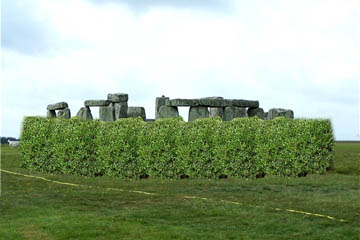Stonehedge?
We all know what Stonehenge looks like - the rugged stone pillars arranged in a circle, the giant slabs of stone that link them, the wide green expanse of Salisbury Plain - but new discoveries show that people in the Bronze Age may have had a very different view of the place.

|
| Is this what Stonehenge may have looked like in the Bronze Age? (An artist's reconstruction of Stonehenge surrounded by a high hedge.) |
The National Trust, the body responsible for many ancient monuments in Britain, has recently undertaken a fresh survey of the site and have identified a double bank that once ran around the monument. The survey, the first since 1919, revealed the banks and archaeological investigation showed that they had once been planted with the sort of plants that are used for hedging. Archaeologists have been quick to speculate that the hedges served as a screen to keep profane eyes from spying on the secret ceremonies that took place, others talk about shielding onlookers from the "power" of the mystic stone circle.
Such speculation is foolish. As any gardener knows, a hedge is a hedge, whether it is six inches high (as in an Elizabethan knot garden) or sixteen feet high. Provided the hedge is old enough, you can't tell from the thickness of the roots how high it had been allowed to grow. There are hedges around the fields near my home that are only three feet high but their stems are gnarled and twisted and as thick as my arm!
It is also not certain that the banks were raised to support the hedges. A hedge naturally builds up a mound beneath it as leaves fall and accumulate and dirt is washed around it and trapped by the hedge itself. It could well be that the hedge was planted and gradually the bank grew beneath it; then, when the hedge died out the bank remained.
The Bronze Age date is interesting, however. Estimated dates for the construction of the monument range from 3000 BC to 2200 BC and the last known work on the monument is around 1600 BC. It would appear that the hedge was planted around a monument that was nearly complete, but whether it was intended to provide beautification for a venerable sanctuary or a screen to cloak it in secrecy is impossible to tell.
Another startling result of the survey is the discovery that there was once a mound in the middle of the stone circle. Water colour paintings from the 1700s show a mound there, but these have previously been dismissed as artistic fancy or plain inaccuracy. If there was a mound, then it may have been related to the many burials found in and around Stonehenge - so many that some suggest Stonehenge was a place of healing and the burials were the failures! What is more likely is that the mound was raised over some important burial - a priest or, more likely, a chieftan or war hero - and the other burials were of people who wished to be associated with the significant personage.
Of course it would be too simplistic to say that Stonehenge was a burial monument. There are too many associated banks and ditches and rows of standing stones: there is the Bluestone Henge down by the riverside, there is the Avenue which leads to the Avebury stone circle, there are other marks on the ground. These, however, could all be related features that grew up as the significance of the original burial mutated into a religious centre.
A parallel may be found at Lourdes or Assisi, where the first simple monument has grown into a vast ediface where thousands can pay their devotions and the original purpose of the monument has been all but forgotten. It may even be that the developed Stonehenge was indeed an astronomical calculator or anything else that the theorists have devised, planted on top of the burial of some Mesolithic chieftan (for that is when the first wooden post holes were dug).
© Kendall K. Down 2010





